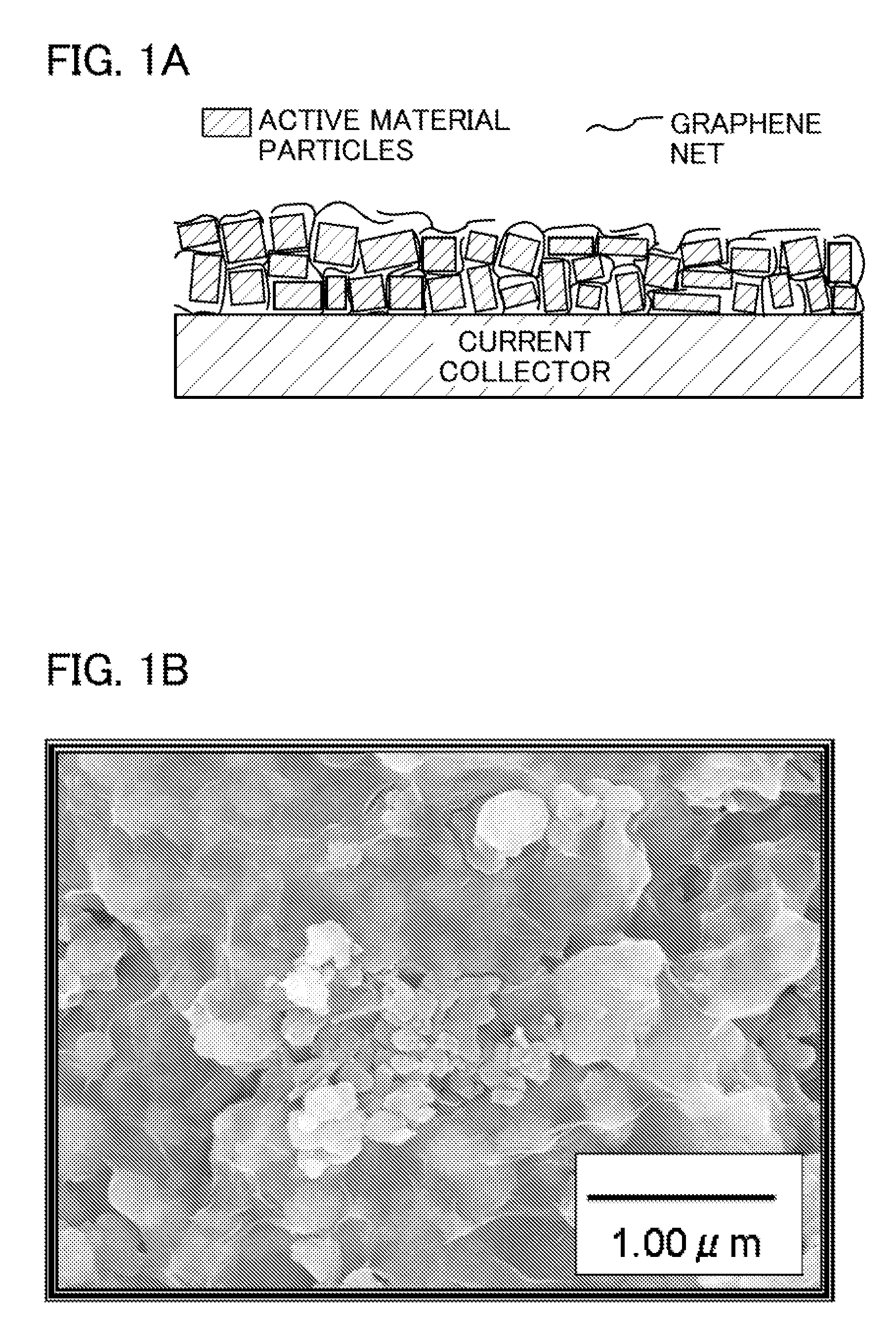Method of manufacturing electrode
a manufacturing method and electrode technology, applied in the field of electric appliances, can solve the problems of difficult to maintain the shape of an electrode, difficult to mix lithium iron phosphate particles and a conduction auxiliary agent uniformly, and difficult to maintain the price and stable supply, etc., to achieve excellent electric characteristics, high reliability, and large electric capacity
- Summary
- Abstract
- Description
- Claims
- Application Information
AI Technical Summary
Benefits of technology
Problems solved by technology
Method used
Image
Examples
embodiment 1
[0054]This embodiment will show a method of manufacturing a lithium ion secondary battery which is one embodiment of the invention. The method of manufacturing an electrode of the lithium ion secondary battery includes a step of mixing a precursor of a graphene net with active material particles, and applying the mixture onto a current collector, and a step of heating this mixture in a vacuum or a reducing atmosphere. As the precursor of the graphene net graphene oxide (or multilayer graphene oxide) can be used.
[0055]The precursor of the graphene net does not particularly need to have a large expansion or be a high molecular compound, but precursors are bonded to each other in the heating step, resulting in polymerization or formation of a high molecule, formation of a larger, three-dimensional network, and formation of the graphene net.
[0056]The following shows details. In this embodiment, an oxidation method called Hummers method is used. First, graphite such as flake graphite is ...
embodiment 2
[0081]Examples of electric appliances according to the invention include a variety of dry batteries, storage batteries, and the like. As an additive to their positive electrodes or negative electrodes, for example, the graphene net described in Embodiment 1 may be used.
[0082]Examples of electric appliances according to the invention further include electric power tools, personal computers, mobile phones, mobile game machines, mobile information terminals, e-book readers, video cameras, digital still cameras, and the like. Such electric appliances are not always supplied with power by a wire and therefore include a storage battery inside. As an additive to positive electrodes or negative electrodes of the storage batteries, for example, the graphene net described in Embodiment 1 may be used.
[0083]In partictilar, a storage battery with low internal resistance is required for applications where a large amount of current needs to be fed instantaneously or where a required current value ...
example 1
[0102]To investigate the effect of a graphene net obtained by reducing graphene oxide, the following two samples were fabricated and their characteristics were compared. Sample A was fabricated by applying a mixture of only active material (lithium iron phosphate) particles and graphene oxide onto a current collector (aluminum) and heating the mixture in a vacuum.
[0103]Sample B was fabricated by applying a mixture of active material (lithium iron phosphate) particles, a binder (polyvinylidene fluoride (PVDF) produced by KUREHA CORPORATION), and a conduction auxiliary agent (acetylene black produced by DENKI KAGAKU KOGYO KABUSHIKI KAISHA) onto a current collector (aluminum) and drying the mixture. The active material particles and the current collector were the same as those of Sample A.
[0104]The lithium iron phosphate particles and the graphene oxide were obtained as follows. First, lithium carbonate (Li2CO3), iron oxalate (Fe(C2O4).2H2O), and ammonium dihydrogen phosphate (NH4H2PO4...
PUM
| Property | Measurement | Unit |
|---|---|---|
| particle size | aaaaa | aaaaa |
| particle size | aaaaa | aaaaa |
| particle size | aaaaa | aaaaa |
Abstract
Description
Claims
Application Information
 Login to View More
Login to View More - R&D
- Intellectual Property
- Life Sciences
- Materials
- Tech Scout
- Unparalleled Data Quality
- Higher Quality Content
- 60% Fewer Hallucinations
Browse by: Latest US Patents, China's latest patents, Technical Efficacy Thesaurus, Application Domain, Technology Topic, Popular Technical Reports.
© 2025 PatSnap. All rights reserved.Legal|Privacy policy|Modern Slavery Act Transparency Statement|Sitemap|About US| Contact US: help@patsnap.com



